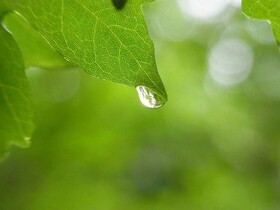


In the water cycle, the water on, in and above the earth, between the atmosphere, water and the ground is considered.It affects the soil, plants and animals.If the water cycle is intact, ideally the soil can absorb all the water from the precipitation when it rains.To do this, the soil should be loose and covered with plants or mulch.The water from the ground then either gets into the groundwater or it is absorbed by plants and evaporates again through their leaves.If, on the other hand, the water cycle is not intact, very little water is absorbed by the soil when it rains.The water drains above ground or evaporates before the plants can absorb it.
The nutrient cycle is the circulation of all elements, molecules and minerals.It is very closely connected to the soil organisms.For example, a nutrient element in the soil is taken up by a root and incorporated into organic compounds in the associated plant.After the plant dies, the element gets back into the soil through degradation by animals and microorganisms.The nutrient cycle can only function properly through constant eating and being eaten.An element then returns to its starting point via successive intermediate stations.The faster the nutrient cycle, the more productive the land is.As long as no substances are permanently removed from the cycle, it remains closed and the system is stable.
The basic processes in an ecosystem are photosynthesis and rotting.The energy flow looks at the movement of solar energy through all living organisms or even those that have once lived.It can be influenced by several factors: the number of plants per area, the size of the leaves and the time.The flow of energy is not a cycle. The energy comes from the sun and flows through the entire system, but does not return to the sun.Energy is lost as heat from one stage to the next.The flow of energy can be increased by covering the ground, always having enough plant mass for photosynthesis and by having different plants with leaves of different widths for the best use of the sun.
Ecosystems, plant and animal communities are constantly changing.The community dynamics describe this never-ending process of changing biological communities.If you consciously or unconsciously change one of the ecosystem processes, this affects all the others.
Community dynamics also mean: The cycle of growth and decay must be kept going in the ecosystem.So individuals of all stages of development should be present in the ecosystem.If, on the other hand, an ecosystem consists only of older plants, animals or trees, for example, this is a sign of a non-sustainable system, as no younger generation can follow the older.
The four ecosystem processes are a central component of the holistic planned grazinh, because the holistic approach is based on a functioning ecosystem.The most important indicator for the general health of the ecosystem and the functioning of the four processes is the soil cover: The system is healthy when the soil is predominantly covered, the cover consists of a mix of healthy and decaying plants and a large biodiversity.If, on the other hand, the soil is bare and only a few types of plants grow on it, the environment can be assumed to be rather unhealthy.In the holistic planned grazing, the focus is therefore on covering the soil to an extent that is appropriate for the local ecological context.In general, the more species-rich an ecosystem, the better, because species-rich communities are stable.
Find out more about the next component of holistic planned grazing: the tools